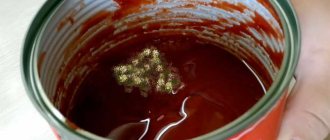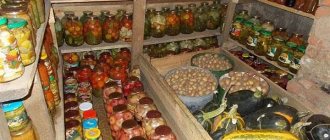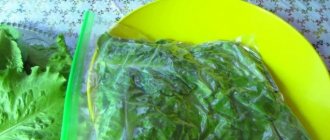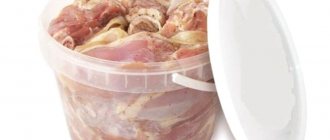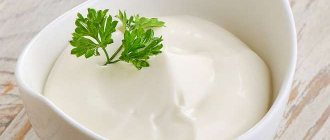Ways to store summer gifts
In order to enjoy a piece of summer in the cold, there are many ways to store vegetables and berries. Since ancient times, two methods have been used to preserve fruits: various processing or canning in airtight containers. The most commonly used methods are drying, sterilization, pickling, pickling, salting, smoking, adding salt, sugar, spices and acids, which are natural preservatives:
- Freezing and cooling. Vegetables, berries and other fruits are put in the refrigerator. With this method, harmful microorganisms are not completely destroyed, but the fresh appearance of frozen products is almost preserved.
- Drying. During drying, a lot of moisture is lost and the concentration of dry substances increases. At high humidity, products become moldy, so you need to use moisture-proof containers to store them.
- Salting and fermentation is based on the preservative effect of lactic acid, which kills harmful bacteria. It is formed during the process of lactic acid fermentation of sugars contained in vegetables. Salt is added to improve the taste of products.
- Pickling is based on the beneficial effects of acetic acid, which is part of the solutions with which the fruits are poured. It is more toxic to bacteria and microorganisms than lactic acid.
Many people, seeing how their mother or grandmother turns over jars of pickles, wonder why they turn over the jars after seaming. This is done to check the tightness of dishes with preservatives. If liquid leaks from an inverted jar or there are bubbles near the lid, the jar is not closed tightly. Air will pass through such places - and the preservatives will quickly deteriorate. They may even explode during storage. If weak spots are found, it is necessary to boil the jars again and repeat the rolling process so that the products do not spoil.
After the jars are rolled up, they are turned over onto the lid and left in this position for a day or overnight.
Now that you understand the technology, you can try some great pickling recipes:
- Green tomatoes
- Cabbage
Why cover jars of preserved food with a blanket?
Preservation jars must be covered to maintain a high temperature for as long as possible. Maintaining a high temperature for a while is an additional method of sterilization.
If the inverted cans do not begin to leak, then you should pay attention to the following signs:
- cloudiness of the liquid;
- the appearance of bubbles;
- inflated lids.
If any of these signs are detected, the canned food must be opened and boiled again. After this, it is closed again, and then it can be eaten.
After the jars have cooled, they can be put in a cold place where they will be stored. Some housewives can observe for some time to see if the brine has become cloudy and if bubbles have appeared there in order to immediately eliminate the cause.
Canning with sugar
With an increased sugar content, part of the moisture that is present in the protoplasm of the cell moves into the medium. Under such conditions, the activity of microorganisms stops and they die. But this only applies to the high sugar content in canned food. At low concentrations, they can become a favorable environment for the proliferation of microorganisms.
Sugar is used to make jam, jam, jelly, marmalade or marmalade from berries and fruits. Why do you turn over jars of jam? Place the jars upside down on a flat, hard surface to make sure the lid is screwed on tightly. In an unsealed container, the contents will spoil or ferment faster.
Do I need to turn over the jars?
Many housewives themselves cannot tell you exactly why they turn the jars over after twisting them. They do it out of habit or because their mothers and grandmothers turned them over. Seeing this, they themselves decided to continue the tradition of turning over, although, according to some housewives, it is not necessary to do this, and in some cases it is undesirable.
Thus, the decision whether or not to turn over jars of preservatives after twisting is up to each woman to decide independently. Many people, after placing the jars upside down, cover them with a blanket or cloth to be safe. It is believed that this will speed up the sterilization process.
According to statistics, jars of canned cucumbers explode much more often than jars of tomatoes. This is explained by a feature in the structure of cucumber fruits. To avoid such problems with twists for the winter, it is necessary to carefully prepare the ingredients and the container itself for creating canned food.
Do I need to turn over jars of strawberry jam?
“How to seal jars with screw caps?” – our mothers and grandmothers ask us, who are completely confused in today’s situation with a sharp jump in household technologies.
More recently, they had to painfully cope with seaming machines, but now in our arsenal there are jars with threads, and supermarkets are full of offers of lids of various brands for such jars.
How to seal jars with screw caps? Easily! No special knowledge or skills are required here. You need to pour the contents into the jar, put on the lid and screw it tightly along the thread. That's all!
For clarity, we will give you a couple of recipes and examples of how to roll up jars with screw-on lids.
- Jar with thread – 1.5 liter.
- Fresh small cucumbers (excellent Phoenix variety) – 2 kg.
- Garlic with large cloves - 1 head.
- Lavrushka – 2 pcs.
- Bell pepper – 1 pc.
- Allspice peas – 5 balls.
- Cilantro seeds (coriander) – 1 tsp.
- Table or apple cider vinegar for preservation 2 tbsp.
- Regular table salt – 2 tbsp.
- Beet or cane sugar – 1 tbsp.
Pour spices into the bottom of the jar - bay leaf, peas, cilantro. Peel the garlic, wash it and place it in the bottom of the jar. Next, place the cucumbers very tightly and closely together. Cut the pepper in half lengthwise and place it between the cucumbers.
Pour boiling water over the vegetables in the jar. Cover with a lid and let stand for 15-17 minutes. After this, pour the water into a saucepan and bring it to a boil again. Pour boiling water back into the jar, add salt and sugar, add vinegar. Take the lid and tighten the thread tightly.
Place the jar upside down and cover it with a warm blanket. It will be possible to remove it in a day. And it is advisable to open and eat it no earlier than in a couple of weeks.
What to prepare:
- Selected strawberries – 1 kg.
- Sugar (sand) – preferably cane – 1 kg.
- Glass jars with screw caps, 0.5 l each – 3 pcs.
Why turn jars over when canning?
Even novice housewives, after placing vegetables and the necessary spices in jars, filling them with water and rolling them up, turn the vessels over. Some do this by adopting the experience of mothers and grandmothers, others read about this need in canning recipes. Many people have no idea why such an action should be performed. Turning over cans after seaming is due to the following reasons:
- Checking the tightness. By placing a container of vegetables or berries upside down, you can see if liquid is leaking under the lid. This is very important because well-sealed foods will not spoil and bacteria will not penetrate into them.
- Sterilize the top parts of the jar. Turning the vessel with hot liquid inside will help warm up and disinfect not only the bottom, but also the neck of the jar.
Do I need to turn the jars over after twisting them? Or is it just tradition
No, this is not a ritual at all, like among fishermen - to spit on the worm. Although, maybe fishermen spit on the worm for a reason!? I have not studied this issue yet. As for cans, turning them over has a clear meaning.
What does this give?
Yes, everything is very simple if you think about it a little. By turning the jar over, it is easier to make sure it is sealed. If it allows air to pass through, it will definitely start leaking. Finding a leak if the can is standing will be difficult. You won’t thoroughly check and listen (is the air poisoning?) to each can.
And, if you turn it over, you can quickly glance over all the preparations and find a leaking jar. When you find such a jar, you can simply roll it additionally with a key so that the lid completely seals all leaks.
Why wrap the cans?
This is the second question that is usually asked along with the first. And here the answer is also quite simple.
The jars are wrapped so that they cool more slowly, and this cooling occurs evenly. This procedure serves as a complement to the sterilization process. Which, again, affects the quality of the workpieces.
That’s all the explanation for this kitchen “ritual” of our housewives. As a bonus, for reading my “notations” and explanations (I hope not completely boring), I give you a link to the article - 5 ways to sterilize jars at home. Choose how to organize this process faster and more efficiently. Oh, this is how you can simply seal a can of paint after use, and it (I mean paint) will not dry out.
Why are banks wrapped?
In the technologies for preparing canned cucumbers it is written that after turning over, the jars need to be wrapped. There are several opinions on the question of why to do this:
- Replacement of sterilization of preservation. The vessel takes longer to cool down and is treated with heat for more time. This means that a more intensive disinfection process is obtained.
- The products turn out tastier. It is believed that with such simmering, the cucumbers will infuse, become better saturated with the marinade and acquire a richer and piquant taste.
- Secure banks. Another explanation is that slow cooling preserves the integrity of the glass. It may crack if, after sterilization and pouring boiling water, you immediately place the vessel on a cold surface.
Twisting cans
To properly and securely tighten the jars, you need:
- Place the metal lid on the jar filled with food.
- Place the screw wrench on the lid and press firmly with your palm.
- Rotate the key handle clockwise until it stops completely.
- Return the handle two to three centimeters back when its movement begins to become difficult, and again forward until it stops completely.
- Remove the key from the can.
To achieve complete tightness, move the handle of the seaming wrench slowly and carefully. Sudden movements can cause the neck of the jar to not withstand the tension and burst.
The tightness can be checked by turning the jar upside down and placing it in this position on a flat surface. The appearance of liquid indicates poor sealing. In this case, the cover must be removed and screwed on again with a new one.
After completing the entire canning process, each jar should be turned upside down, placed in the prepared place and covered with two blankets. Leave the preservation in this form until it cools completely for one or two days. Afterwards, remove the jars to a dry place and store at room temperature.
Share this article with your friends on social media. networks:
Why do jars of cucumbers become cloudy and explode?
When pickling or pickling cucumbers, every housewife fears that the jars will explode, their contents will become cloudy, and an unpleasant odor will arise. Such incidents happen often. The reason why jars of canned cucumbers explode can be due to various conditions, which are based on the carelessness of the cook or poor-quality containers where the preserves were placed. To avoid misfortunes and not have to redo everything, you need to carefully follow the recipe and take precautions when selecting containers.
Air getting into cucumber twists
Before planting cucumbers, you need to select them. Small, strong and fresh fruits without cavities inside are suitable for preparations. This is an important rule, since large cucumbers tend to accumulate air and bacteria. Microorganisms, once preserved along with vegetables, continue their activity, emitting gases. The volumes of gaseous substances and air that are released from the cucumber cavities grow, gradually filling the jar. As a result, the vessel explodes. To prevent this from happening, experienced housewives recommend soaking cucumbers for several hours.
Violation of cooking technology
When rolling cucumbers for storage under iron lids, the sequence and technology for preparing canned food must not be violated. It is important to thoroughly rinse the cucumbers and all the seasonings needed for pickling. Otherwise, along with contaminants, microbes will get into the jar, which can cause jars of cucumbers to explode in a few minutes. The leaves of the necessary plants, dill umbrellas and garlic should be thoroughly washed.
Poor preparation of canning jars
A common reason why jars of pickled cucumbers explode is poor preparation of the container. This factor can affect the safety of homemade preparations in 2 cases:
- In case of improper sterilization. Sterilize the jars over steam and the lids in boiling water for as long as indicated in the recipe. There is no need to shorten this period, it is better to increase it a little, since insufficient treatment can leave many microorganisms alive. After steaming the jars, you must immediately add the ingredients into them. This needs to be done as quickly as possible. You should roll up the lids that have just been removed from boiling water.
- If the container is not clean enough. Be sure to keep the jars clean and intact. A lot of dirt accumulates on the neck and must be completely removed. The upper part must be intact, otherwise air may enter during rolling, which causes fermentation.
Violation of the recipe
The reason why jars of cucumbers explode may be the neglect of the proportions described in the recipe. Substances that are necessary to preserve cucumbers in winter must be added strictly following the recipe. Otherwise, you risk getting an unexpected taste or starting the fermentation process. Add vinegar, salt, sugar and citric acid in the amount prescribed by the recipe, and not at your own discretion, so as not to harm homemade preparations and do not re-twist.
What varieties of cucumbers are suitable for canning?
To get high-quality cucumber pickles without the possible explosion of jars, you need to choose the right varieties for preservation. There are selection criteria:
- Vegetable size. Choose cucumbers about 10-12 cm in size. Such fruits are convenient to place in jars; they look very appetizing.
- Peel thickness. Cucumbers with thick skin come out crispier when rolled. It’s easy to identify a suitable fruit: try to pierce it with your fingernail. If this is difficult, then the skin has a suitable density.
- Color of the thorns. Fruits with black thorns are suitable for pickling, marinating and creating lightly salted cucumbers. These varieties pass brine well and are very tasty. Vegetables with white spines are best left for making salads.
- The color of the skin of the fruit should be dark. It indicates the appropriate variety and degree of maturity of the vegetable. Light and yellow shades are signs of overripe cucumbers, which may have cavities inside with air, which can provoke fermentation. Excessively ripe fruits have large seeds, which are not very pleasant to eat in canned form.
Is it necessary to turn the jars over after twisting? This question interests many young housewives. When canning at home, jars sealed with ordinary tin lids must be turned over, placed on the lid and allowed to stand for a certain time.
This is done for the following reasons:
1. The tightness of the blockage is checked. In the normal (non-inverted) position of the jar, it is impossible to see whether the lid fits tightly or whether water is leaking out. The presence of water in the jar does not prevent air from entering the unsealed container. If you turn the jar upside down, it’s immediately clear whether there is a leak. When cooling, if the jar is sealed, atmospheric pressure presses the lid even harder;
2. Additional sterilization of the lid itself and the top of the jar occurs. This increases the reliability of heat treatment of preservation.
Modern housewives are increasingly using screw (screw-on) lids for homemade preparations. To ensure the best results when using such lids, manufacturers recommend leaving the preserved jar in its normal position (do not turn it over). But for additional sterilization and checking the reliability of the closure, you can turn the jar over to see if the lid fits tightly, and place it on the bottom until it cools completely.
The process of canning is not only a fun and interesting creative activity, but also a good way to significantly reduce the number of nerve cells. This happens especially often if you are irresponsible in preparing to work with workpieces, without checking the quality of the devices used. The ceiling and walls of the basement stained with delicious adjika or aromatic jam after the explosion of the jar is evidence that a gross mistake was made in the process of preparing the preserve. Most often this happens due to poor quality preparation of glass containers. How to do this correctly so that you can enjoy delicious marinades, pickles, and jams all winter?
A little about lids
Ordinary tin lids are especially popular among housewives.
Their main feature is their low cost. This is especially important if there is a lot of food stockpiled for the winter. Also, metal lids are easy to use, great for many types of jars, and perfectly seal containers.
Screw iron lids also received good reviews.
Reusable use is the main characteristic of such a device. It is worth noting that ideally they seal the jars only 4-5 times.
Pre-treatment before you start canning is as follows - the lids should be rinsed well with warm water and soda. Why do this? Often screw caps are sold not in packages, but in bulk; dust can collect on them, which will certainly affect the shelf life of the contents.
After washing, the lids must be sterilized.
This is easy to do:
- Place a metal rack in a wide pan.
- Place the rolling device on it in one layer, pour in water (a few centimeters above the lids) and boil for several minutes.
Before the procedure, do not forget to remove the rubber bands: contact with boiling water will quickly deform them and become unsuitable for further use.
Selection of cans
Before you begin the pleasant process of sending vegetables and fruits to jars, you need to decide what volumes of containers you will need.
Small jars (0.5 and 1, or 0.7 l) are convenient for storing jams, condiments or sauces for long-term storage. Larger containers (1.5 and 3, or 2 liters) are perfect for canning pickled vegetables or compotes.
Banks must be carefully inspected.
First, you should look at the production date (it is most often stamped on the bottom). Every year the risk of damage to glass containers in the form of chips on the neck increases. They allow air that is detrimental to preservation, and can also cause further damage by the seaming machine.
It is not recommended to use glass jars with a thick seam.
Quite often it transfers to the neck, which makes capping difficult. Also, while using the seaming machine, the seam may burst, glass shards will ruin the entire contents and you will have to throw it away.
You can use Euro jars to roll up jam or your favorite seasoning. Now there is a large selection of such containers of non-standard shape; they not only store the contents wonderfully for a long time, but also look very beautiful on the shelves.
If possible, it is better to purchase any device in Auchan - a specialized store. In it you can find everything for preservation - different types of jars or lids, a reliable seaming machine, tongs or a grip, and other improvised devices.
Advantages and disadvantages of screw caps
Screw lids are especially popular among modern housewives. They are easy to use and do not require the use of a seaming machine. Twist-offs fit tightly to the neck of the container and allow the preservation to withstand long-term storage. Screw caps can be reused.
Screw caps have one drawback - they can sometimes be very difficult to remove from the jar. But, knowing some tricks, you can easily open such canned food.
Preparing glass containers
Regardless of what jars you need for canning, you need to prepare them carefully so that you don’t have to find out later why marinades prepared with such difficulty explode.
The first stage is a careful inspection of the container.
This will help identify cracks, chips, and other damage. During heat treatment, such containers will inevitably burst and all the work will go down the drain.
The next step is cleaning the container.
It is necessary to remove the remnants of previous marinades or jams, if any. It is better to wash the jars with hot water with the addition of soda - it will perfectly help remove the smell, even if the containers previously contained aromatic sausage with garlic. You can use any dishwashing detergent for such purposes.
After preparation, you need to rinse the container several times under running water.
Some housewives use only boiled water to wash containers. This is not necessary; you can scald it with boiling water, the result will be no worse. Use boiling liquid carefully; glass jars may be damaged. After scalding, containers can also be sterilized. If the jars are small, a regular microwave will be a great help to cope with such an important process. It is better to put containers of several liters in a hot oven.
Resourceful housewives learned to use a kettle to prepare jars for canning. To do this, you need to open the lid, pour in water, place the jar on top with the neck down and turn on the device. This process replaces labor-intensive scalding: steam from boiling liquid will do a great job.
The final stage of working with banks
The container is filled with delicious preserves; all that remains is to seal the jars well. The main role here is played by the lids and the seaming machine.
You need to skillfully close containers with a twist; not everyone succeeds the first time.
Regardless of how glass jars were sealed - with a key or a screw cap - you need to check the quality of the closure. How to do this?
If done incorrectly, the contents will slowly leak out, signaling that you need to tighten the cap better or replace it with a new one.
Another important point: after capping, try to twist the lid on the jar with your fingers.
If it rotates along its axis, the seaming quality is poor, it is better to change the device. Do not neglect these simple rules: it is better to repeat the process several times than to throw the spoiled contents of the cans into the trash after a while.
- When purchasing lids with a shiny varnish coating, you must check the quality of this application: rub a cotton pad moistened with acetone or alcohol on the inside of the device. If there are traces of varnish on the cotton wool, it is better not to use such lids - the shiny coating can, under the influence of vinegar, happily become a seasoning for your favorite cucumbers or tomatoes.
- You can also check in advance whether the screw cap seals well and whether there is a flaw in the glass container. After collecting some liquid in the jar, seal the container tightly and place it on a sheet of paper. If the contents leak, the paper will quickly become saturated with moisture. You can try to do this with a different lid; if the result is the same, you will have to throw away the jar or adapt it for other needs - it is not suitable for preservation.
- It often happens that after filling jars with hot jam or jam, a disaster occurs: the container, previously intact and quite reliable, cracks and becomes completely unusable, threatening to ruin the contents. To prevent this from happening, you should put a few spoons of the hot product and twist the container a little with your hands so that it warms up well. Only after this can you safely fill it to the very top.
Warming up in the oven
This method is convenient because you can sterilize both twist-offs and jars together.
Heat the oven to +50°. Place screw caps and glass jars in it. After 10 minutes, increase the temperature to +100° and sterilize the products for another 15 minutes.
Be sure to increase the temperature gradually. Otherwise, glass jars may burst. Also remember that containers and lids for preservation cannot be sterilized in a microwave oven.
"Dad is offended." Agata Muceniece about her relationship with Priluchny after the divorce
Smooth and fresh skin: dermaplaning, or why a woman needs to shave her face
“We are still friends”: Derevianko commented on the breakup with his wife
Selecting jars and lids to prevent food from exploding (video)
Properly prepared jars and lids will help preserve your favorite preserves for a very long time. Do not neglect the basic rules of preparation, then your mood will not disappear at the sight of spoiled food, and the time spent in the kitchen will not be wasted.
The age of technological progress leaves its mark on society. More and more housewives are looking for optimized household items, be it multicookers, electric kettles or blenders. Products of this kind include screw caps that make life much easier. Of course, seaming machines are not a thing of the past; many people still use them to seal pickles. However, more modern housewives prefer not to bother. Let's look at the important aspects in order.
Advantages and disadvantages of twist-off caps
The older generation remembers well how much effort and care was required to seal cans with ordinary tin lids. With the advent of glass containers with threaded necks, seaming machines became unnecessary.
Twist-offs do not require great physical strength, but problems still remain:
- screw caps are more expensive than regular ones;
- Suitable only for jars with threaded necks;
- sometimes they are difficult to open without a special key.
Advantages of screw lids for canning:
- affordable price;
- no seaming machine required;
- no special device is needed for opening;
- can be used for any type of preservation.
Instead of threads, there are special stops on the sides of the lid that slide along a spiral groove on the neck. The inner surface is coated with a special food varnish; there is a small seal around the circumference to ensure tightness.
Screw caps are produced with a diameter of 100, 82, 66, 38 mm. This allows you to use containers of any size for canning.
The varnish coating over the entire surface should be smooth, shiny, without sagging or blistering. Cracks and scratches are not allowed. If metal is visible through the damage, it is dangerous to use such a lid for any type of preservation.
How screw caps work
Today, screw caps are widely used in America and Europe. Products of this kind are called “Twist-Off”; their operating principle is quite transparent.
The inside of the lid has a slippery polymer coating that serves as a gasket. As a result of exposure to high temperatures, this element swells, significantly increasing in thickness. This move allows you to press the lid to the neck of the jar as tightly as possible, preventing air from entering and, as a result, spoilage of the final product.
Thanks to their powerful sealing, screw caps are suitable for preserving jams, pickles, canned goods, etc. When the temperature drops, the gasket shrinks, which is accompanied by a click. The lid sags deep into the jar, this move creates a vacuum effect. Before rolling up pickles using lids like these, they need to be well heated.
Technology for sealing jars with screw caps
Any housewife wants to get the correct answer to the question: “How to properly close jars with Twist-Off lids?” In this case, the process does not present any great difficulties. However, like any other business, it includes certain features that must be taken into account. Twisting will not take much time.
- First of all, inspect each cover for the presence, or rather the absence, of all kinds of defects. The surface of the cover should not have rust “bugs”, strong dents (if possible, exclude such specimens altogether), small and large scratches.
- After you have inspected the lids, they need to be sterilized. The procedure is carried out through thermal treatment. Pour running, or preferably filtered, water into an enamel pan, place it on the stove, and bring to a boil. When the first bubbles appear, place the lids in the container, reduce the heat to medium, and cook household items for a quarter of an hour.
- After the specified period has passed, spread a cotton towel on a flat surface, remove the lids with kitchen tweezers, and leave until completely dry. Sterilization should be carried out immediately before preservation.
- After cleaning the lids, proceed to tighten them. Pour the desired contents into the jars, place the lid on top of the neck, and screw it on. To check the tightness of the rolled container, turn the hot jar upside down, cover with a towel and leave until it cools completely.
- If the rim does not become wet, it means the preservation was successful. In this case, the jars must be taken to a cellar or basement for long-term storage.
How to roll
Before rolling canned food, make sure that the grooves on the rim of the twist-off lid line up with the twist line on the glass jar.
Sterilize the jars. Fill them with food for canning. Use tongs to grab the sterilized lids and place them on the containers. Cover the twist-off with a clean towel and twist with your hands.
Don't try too hard. Otherwise, you will twist the thread and the seal of the canned food will be broken.
How to Store Screw-Lid Jars
- Jars sealed with screw caps should be stored in a room with optimal humidity (up to 40%) and a stable temperature. An ideal option would be a ventilated pantry, a dry basement or a glazed loggia. Give preference to rooms or areas that are well ventilated. This move will prevent the formation of mold that appears due to condensation. Important! Do not store jars with screw caps in the cellar, as the humidity in such a room is too high. You should also not keep containers on an open balcony, where the temperature often fluctuates.
- If jars of homemade twists are small (canned food, jam, etc.), store them on the bottom shelf of the refrigerator or in the cellar. This category refers to compounds prone to rapid fermentation, so the room should be cool.
- Do not rush to send jars with seaming for long-term storage immediately after conservation. First you need to place them with the neck down, wrap them in a warm cloth and cool to room temperature. After performing the leak test, check that the cap is not bulging. If everything is in order, the containers can be moved. Homemade pickles are stored in jars with such lids for six months or longer.
- The service life of screw caps is quite long provided all operating conditions are met. If you do not find rust, dents, or large scratches on the product, the lids are reusable. If you clean the varnish coating with a hard sponge, the product will quickly become unusable. As a rule, the duration of service varies from 3 to 5 years.
How to open a screw top jar
There are often cases when even the most experienced housewives complain that they cannot open a jar with a screw-on lid.
The difficulty lies in the impossibility of asking a representative of the strong half of humanity, who is not always nearby. At the same time, you also don’t want to spoil the product by making a hole in the surface with a knife to let out excess air.
To simplify the procedure, turn the container upside down and hit the bottom with your palm several times. After this, try unscrewing the cap and repeat the procedure if necessary.
It is not difficult to roll up jars with screw caps if you have sufficient knowledge regarding the available technology. First, sterilize the lids, pour the contents into containers, and immediately screw them on. Store in a temperature-stable room where humidity fluctuates within acceptable limits.

